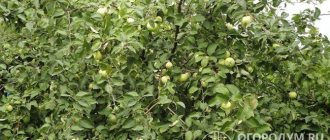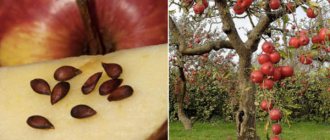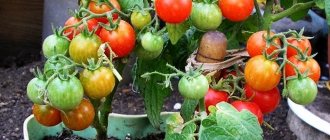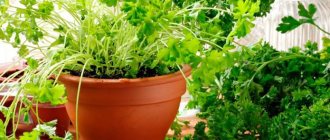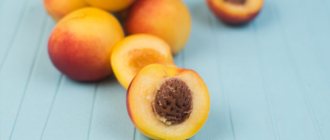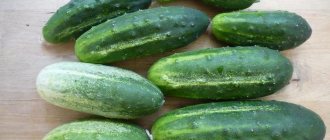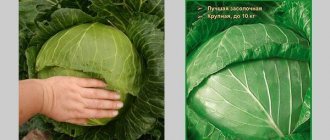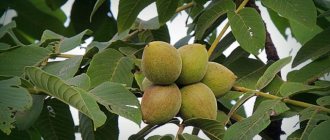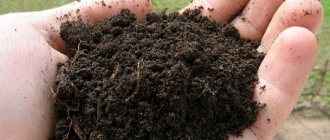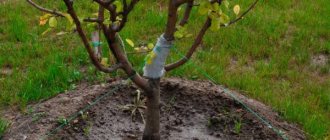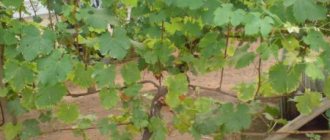What type does it belong to?
The Bolotovskoe apple tree is a frost-resistant, winter variety with good immunity , possessing the Vf gene, which makes apple trees immune to the scab pathogen.
Fruitful. From 1997 to 2002 it was tested according to the State Test Program. In 2002 it was entered into the State Register.
Winter varieties of apple trees also include: Zavetny, Lada, Persianka, Rossoshansky and Yubilei Moskvy.
Which rootstock should I choose?
Whatever the variety of apple tree, its seedling is grafted onto different types of rootstock. How do they differ and which one to choose:
- Medium-sized rootstocks (MM 106, 54, 57-490, etc.) give the seedling good growth vigor. Apple trees grafted onto such a rootstock grow up to 5-6 m in height;
- Semi-dwarf rootstocks (M7, M 26, 63-396) have medium vigor. Such trees grow 4.5-5 m in height. Rootstock 63-396 is especially successful; it increases the frost resistance of any scion;
- Dwarf rootstocks (M9, PB9, etc.) form a low and early-fruiting tree. The height of an adult apple tree does not exceed 3-3.5 m.
Pollination and storage
The Bolotovskoye apple tree is self-sterile. The best pollinating varieties are autumn and winter varieties.
To increase the shelf life ( up to 5 months from the date of picking ), the fruits are placed in refrigerators.
Properly selected humidity and temperature in storage will ensure that Bolotovsky apples retain their original taste and consumer appeal throughout the entire storage period.
Features of ripening and fruiting
Precociousness
The tree is considered early-bearing - it produces its first harvest within 4-5 years after planting. The earliest harvest is brought by seedlings on a dwarf rootstock - they bloom 2-3 years from the moment of planting. A columnar apple tree will produce the first apple in 1-2 years.
Fruit ripening time
The Bolotovskoe apple tree is an early winter variety of apple. Technical ripeness of its fruits occurs at the beginning of September . At this time, the fruits are suitable for home preparation and canning. After a month of storage, the apples become softer and sweeter.
Bolotovskoye apples ripen in September.
The Boltovskoye apple tree tends to lose its harvest if harvesting is delayed.
Harvest shelf life
If stored properly, apples will last until mid-February (5 months), without losing their marketable and consumer properties. Mandatory storage conditions:
- Cold place with a temperature of 2 to 8 °Ϲ;
- High humidity, from 60 to 80%;
- The integrity of the fruits themselves, without wormholes or bruises.
Bolotovskoye can be stored for up to five months.
Watch the video on how to preserve apples correctly and for a long time in winter:
Productivity
The tree's yield is high , reaching 130 centners per hectare . For comparison, the Antonovka variety produces 70 centners per hectare under similar growing conditions.
Attention! If the lower branches of the apple tree are overloaded with the harvest, they may break. Place supports under them or tear off some of the apples.
Description of the Bolotovsky variety
The crown of specimens that have not been pruned is closer to spherical with a slight expansion in the upper part. The basic branches deviate from each other during development, so the crown is not thickened.
The height of the tree is above average. The seedlings grow quickly, and both the root system and the above-ground part of the tree develop at the same time.
Trunk and branches with smooth bark. The shoots are brownish in color, with a small percentage of edges, faceted in cross-section.
A larger percentage of the green mass of trees of the Bolotovsky apple variety is represented by large dark green leaves of a slightly elongated shape.
The veins are clearly visible, abundant, and coarse, causing the foliage to appear wrinkled. The surface of the leaves, sitting on thick and strong petioles, is shiny. The edges are serrated and crenate, the upper part is prone to curling.
The flowers are on long stalks, saucer-shaped with rounded petals, white, pinkish at the stage of developing buds. When opened, the petals are located separately. The anthers rise above the stigmas, the pistil column is pubescent.
The taste of the fruit is sweet and sour, pleasant, delicious , which is why the Bolotovsky apple is classified as a dessert variety. The fruits are large, flattened, weighing up to 160 g.
The following varieties can also boast of excellent taste: Orlovsky Pioneer, Ekranny, Bolshoye Narodnoye, Orlinka and Aromatny.
Broadly ribbed, at the stage of technical maturity greenish-yellow or light yellow with a white tint.
When fully ripe, a distinct pink-red blush appears on the peel, formed by numerous stripes and specks. The surface of the peel is oily and does not have a waxy coating.
The juicy pulp has good density and a soft green hue. The peduncle is strong, thick, erect.
The section shows that the funnel is of medium depth and narrow. Taste rating on a five-point scale – 4.27, external consumer attractiveness – 4.3 points.
Species features
The Bolotovskoye apple tree, description, photo, reviews about which we publish, is a fairly tall (5-8 m) tree. Young crops and seedlings grow quickly, developing both the above-ground part and the root system. The trunk and skeletal branches are covered with smooth gray-brown bark. The current year's shoots are brown, slightly pubescent, and have noticeable edges in cross-section. The leaves of the variety are shiny dark green, oval with a pointed tip and serrated edge. They have an abundance of coarse veins, from which the leaves are noticeably wrinkled, and their tops curl.
The flowers, which open in late spring from pinkish buds, are on long stalks and are saucer-shaped with round, separately located petals, white. The Bolotovskoye apple tree is self-sterile, that is, it requires pollinators for fruit formation. The best of them are autumn and winter varieties.
Photo
Region of growth and distribution
The variety is adapted to cold winter conditions and is recognized as suitable for industrial cultivation in climatic conditions characteristic of the Central Black Earth region.
Tolerates frosts down to -38C. At -42C young shoots are damaged.
It is also suitable for growing in regions with a warmer climate, for example, in the southern regions of the Russian Federation and Ukraine.
The following varieties are also suitable for planting in this region: Golden Delicious, Malinovka, Starkrimson, Uslada and Quinti.
Growing in regions
The Bolotovskoye variety is zoned in the Central Black Earth region. It adapts to the natural disasters of this area; the apple tree tolerates rain and severe frosts.
The regions that are located south of the strip on which Moscow is located are simply cozy for Bolotovsky. Here the climate is more gentle, and there are no special growing requirements.
Growing in the northern regions is possible, but planting on a frost-resistant rootstock will be required. It is better to choose semi-dwarfs or dwarfs to make them easier to cover. A number of measures will also be required to cover the trunk and roots. But for normal pollination a high positive temperature is required, so the amount of harvest can be significantly reduced.
Productivity
The yield is stable, and under favorable climatic conditions is annual (if there were no frosts or prolonged rains during mass flowering).
IMPORTANT! Delays in harvesting can lead to significant losses of fruits suitable for further storage or sale as a fresh product, as apples begin to fall en masse.
Active fruiting begins from the 7th–8th year of development of the grafted seedling.
One mature tree can produce up to 200 kg of apples per season . Technical maturity of the fruits occurs in mid-September.
The following varieties also demonstrate excellent productivity: Winter Grushovka, Shtrifel, Aloe Early, Marat Busurin and Antonovka ordinary.
Pest and disease control methods
The Bolotovskoye variety has the highest resistance to scab and good immunity to fungal diseases.
However, unfavorable climate conditions and violation of basic rules of agricultural technology can provoke the development of other, no less dangerous ailments:
- powdery mildew;
- fruit rot;
- cytosporosis;
- bacterial burn;
- black cancer.
Simple preventive measures will help fight diseases:
- regular loosening of the soil and destruction of weeds;
- clearing the soil of vegetation;
- whitewashing the trunk and skeletal branches;
- systematic treatment of wood with Bordeaux mixture and copper sulfate solution;
- spraying the plant with fungicidal and insecticidal preparations.
The fungicides “Horus” and “Skor” have good effectiveness against diseases. In the control and prevention of pests, insecticides “Aktara”, “Inta-Vir” or “Karbofos” are recommended. It is recommended to carry out disinfection twice a season - before the flowering phase of the plant and after the formation of ovaries.
The hybrid has excellent winter hardiness and is able to tolerate low temperatures, down to –38 C. When growing a tree in a warm climate, there is no need to take special measures to cover the plant. It is enough to wrap the tree trunk with natural, breathable material or special insulation.
In winter, it is recommended to make a snowdrift around the trunk, up to 1 m high.
Planting and care
Agricultural technology for growing apple trees of the Bolotovskie variety is typical for the crop.
Seedlings are planted in open ground at the beginning/middle/end of the second month of spring or in the fall - a month to a month and a half before the onset of cold nights with frosts on the soil.
When choosing a place to plant a Bolotovsky apple seedling in a small garden, preference is given to sunny areas , away from areas with close groundwater.
Fertilizers added to the planting hole (compost, humus, peat, potassium sulfate, superphosphate, ash) will provide the seedling with adequate nutrition throughout the first year of growth.
Everything a young tree needs in the twelve months following planting is timely watering, loosening, protection from rodents and insects.
Any leguminous crop sown in tree trunk soil can serve as a natural source of nitrogen.
Bolotovsky apples are quite unpretentious in care. By providing proper agricultural practices to trees at a young age, the gardener automatically reduces the amount of problems that arise with trees that have fragile “health” due to lack of care during the first five-year period of growth.
Basic elements of the required agricultural technology:
- Timely soil treatment (loosening after rains and watering, removing weeds).
- Application of complex fertilizers, starting from the second year of development (taking into account the composition of the soil).
- Removing damaged branches.
- Crown formation after sap flow stops.
- Protecting the trunk from rodents in winter (tying the lower part of the trunk with coarse bark from a healthy tree, wire mesh over a layer of reeds, straw).
- Preventive measures against burns of the trunk and skeletal branches (tying with burlap, whitewashing).
- Spraying against caterpillars, sawflies, ants and other insect pests.
How to plant and properly care for
By following all the rules of agricultural technology when planting a seedling, you can significantly increase the yield of an adult tree and increase immunity.\
Selection and preparation of seedlings
Only healthy seedlings with a well-developed root system are suitable for planting. The roots should be elastic and the branches should not show signs of damage. Before planting, the rhizome is dipped in a liquid clay solution. You can also soak the root system in a growth activator a few hours before planting.
See also
Why does mold appear on the trunk of an apple tree and how to deal with the disease, preventionRead
Optimal timing
Seedlings are planted in spring and autumn. In spring, apple trees are planted from April to May. In autumn, trees are planted from mid-September to October. Autumn is considered the most favorable time for planting seedlings.
Choosing the best place to land
It is recommended to plant an apple tree in open sunny areas. Trees should be in the sun most of the day. The distance between other trees is left at least 3 m.
Procedure technology
In 2 weeks, the soil is dug up, a hole is dug out and the top layer of soil is mixed with manure and bone meal.
Planting stages:
- Place the seedling in the hole.
- Spread the roots and cover with soil.
- Drive a stake and tie the trunk of an apple tree to it.
The last step is to water only the planted tree with warm or sun-warmed water.
